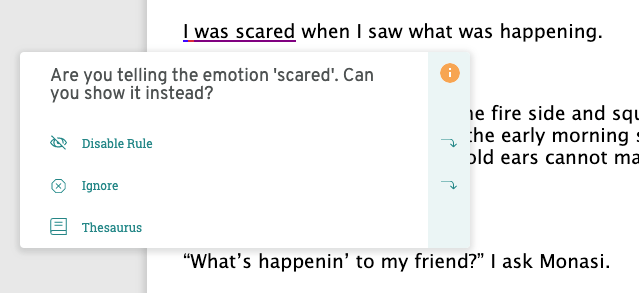
Think about the scariest books you’ve ever read. What made them so scary? In most cases, it’s the author's ability to make you feel the same anxiety, dread, and terror that the characters were feeling as you read the book.
A good horror author can make their reader experience the same visceral reactions and emotions as their characters. They do that by using descriptive language and "showing" emotions, rather than telling them. In this article, find out how to use ProWritingAid’s emotion tells check to craft more engaging horror stories.
What "Show, Don’t Tell" Means for Horror
Many writers make the mistake of telling their readers how their characters are feeling rather than showing that through descriptive language. "Showing" creates a more vivid, engaging experience for your reader.
Consider the following example from Mary Shelley's Frankenstein:
... a cold dew covered my forehead, my teeth chattered, and every limb became convulsed: when, by the dim and yellow light of the moon, as it forced its way through the window shutters, I beheld the wretch — the miserable monster whom I had created. He held up the curtain of the bed and his eyes, if eyes they may be called, were fixed on me.
This passage creates a visceral experience for the reader. You can imagine what it feels like to have cold sweat on your own forehead. If you close your eyes after reading the passage, you can picture the main character, Victor, lying in his bed, watching the monster in a sliver of moonlight.
That’s because Mary Shelley has done a fantastic job of showing, not telling. Here’s how the passage would sound if she did more telling than showing:
I woke up feeling nervous and scared. I squinted in the moonlight and saw the monster peering down at me.
This sample passage communicates the same thing, but without all the profound emotion that Shelley crafted. When you tell what a character feels instead of showing their feelings, actions, and emotions, you’re creating a less powerful experience for your reader.
How to Use ProWritingAid to Transform Your Horror Writing
If you’re writing horror, ProWritingAid can help ensure your writing is full of strong emotions. The Style Report flags instances in your writing where you have told the reader how your characters are feeling, rather than shown it through descriptive language.
Here’s an example of what an emotional tell suggestion looks like:

It’s up to you to decide how to fix a "Show, Don’t Tell" suggestion. If you’re struggling to come up with a better description, try the "Camera Test."
Close your eyes and picture the scene. Where are your characters positioned? What is their body language like? What are they wearing? What is the expression on their faces? What do their surroundings look like? How are they interacting with their surroundings?
Use those questions to rewrite your passage using more descriptive language. Once you’ve finished, ask yourself: "If this were a movie, could a camera capture all of the detail I just added?" A camera can capture the bead of sweat dripping down your main character’s forehead, but it can’t capture the feeling "scared." If you’ve passed the "Camera Test," then you’ve likely done a good job creating that visceral showing experience for your readers.
Final Thoughts
Good horror writers use language to make their readers feel strong emotions like fear, anxiety, and terror. By using ProWritingAid’s Style Report, you can find instances where you’ve told about emotions instead of shown them. Then, you can make those passages more descriptive, creating that delicious dread horror readers crave.


